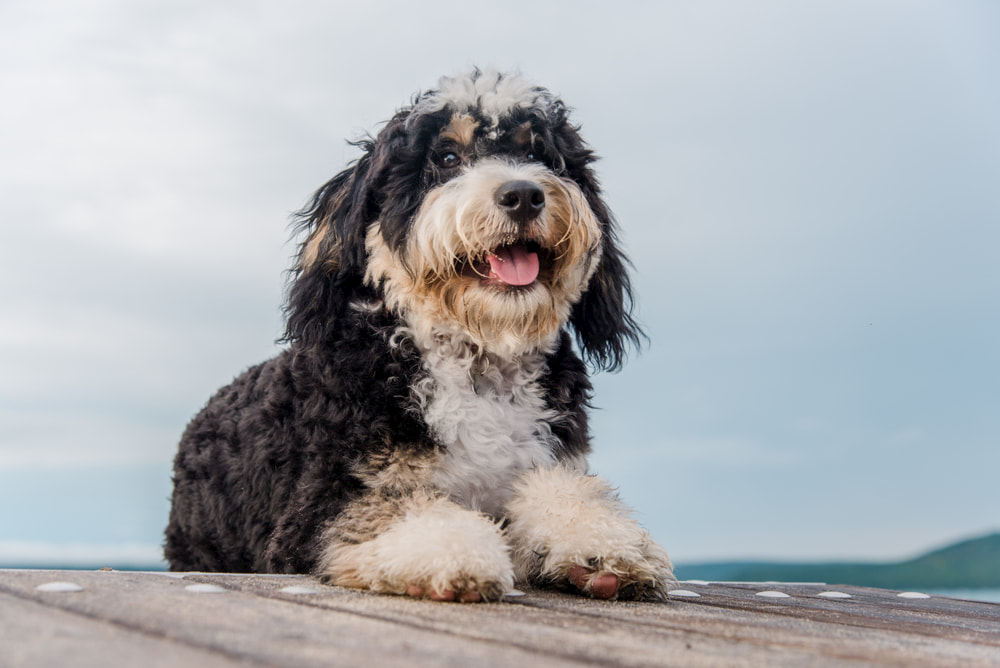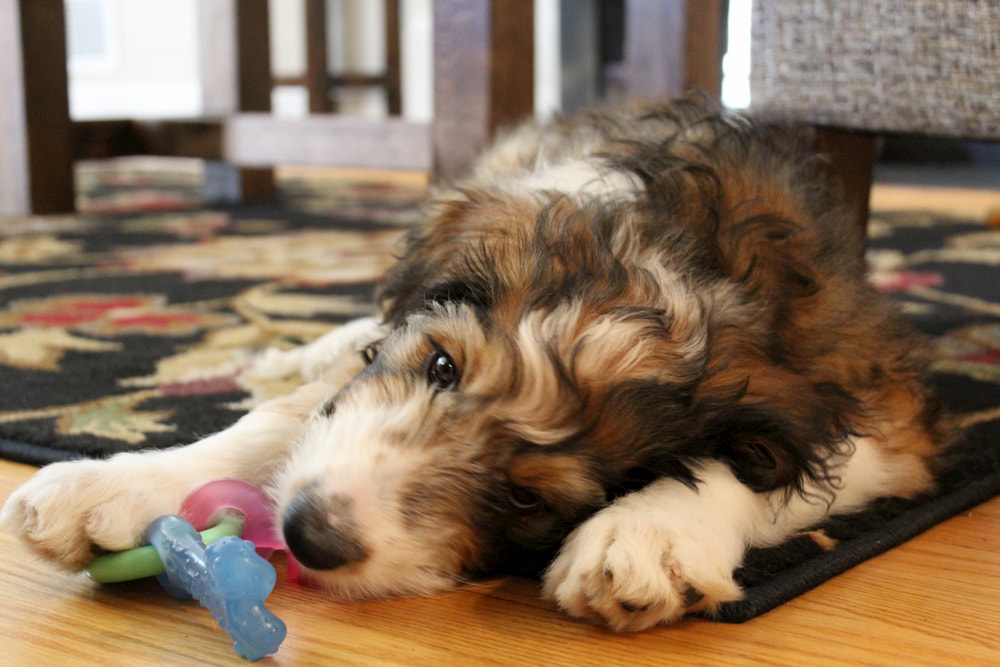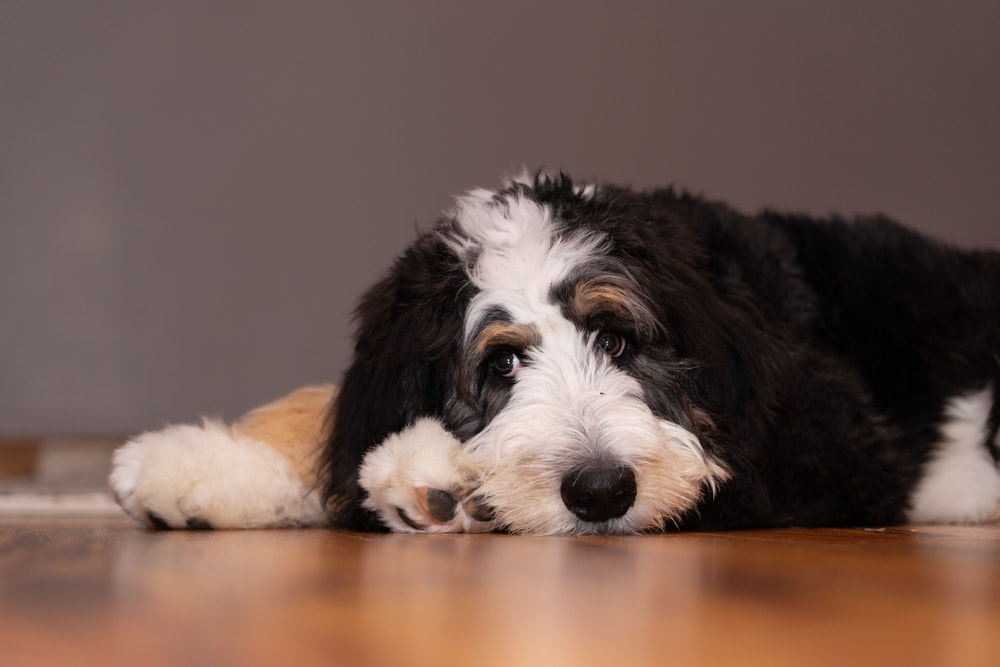Bernedoodle

Breed Details
- Average Height: Standard = up to 29 inches tall; Mini = up to 22 inches tall; Tiny = between 12 to 17 inches tall
- Average Weight: Standard = 50 to 90 pounds; Mini = 25-29 pounds; Tiny = 10 to 24 pounds
- Coloring: Black, black and white, black and brown, and tri-color (black, white and brown)
- Coat Type: Wavy and curly
- Dog Breed Group: Hybrid
- Average Lifespan: 12 to 18 years
- Key Personality Traits: Loyal, clever, and goofy
The delightful Bernedoodle, a cross between Bernese Mountain Dog and Poodle, is the perfect companion for an active family. This loyal and loving dog, also known as Bernese Mountain Poo (cue the toilet humor!), possesses the smarts of the Poodle and the gentle personality of the Bernese.
This outgoing dog breed enjoys the company of his humans and the great outdoors. While not as well-known as the Labradoodle or Goldendoodle, these teddy bear-like dogs are growing in popularity.
History and Origin

Sherry Rupke, a Canadian dog breeder and owner of Swissridge Kennels, created the Bernedoodle hybrid in 2003 to please her customers loyal to the Bernese Mountain Dogs, who wanted a dog similar in temperament but with a longer lifespan.
“I first decided to breed the two because of the health benefits of mixed-breed dogs,” says Rupke. “The second reason was they are great for most people with allergies (when bred right). If you do have allergies it is important to talk to your breeder so they can find the proper coat type for your allergies.”
The Bernese Mountain Dog, according to “The Ultimate Guide to Dog Breeds” by Derek Hall, is an affable canine that arose from the “crossings of local Swiss herding dogs and a type of guard dog brought by invading Roman armies into what is now Switzerland about 2,000 years ago.” The dog is stocky and powerful and belongs to the working group. The breed has been used to pull produce carts from the market. Today, the Bernese is best suited for country life where he can roam around.
As for the Poodle, Hall states that this high-spirited breed originated in Germany and was taken to France. Poodles were originally used as truffle hunters and retrievers because of their water-loving nature. Poodles are also known for their intelligence.
The Bernedoodle has the smarts and longevity of a Poodle and the caring and fondness towards children of a Bernese, but he is not riddled with the health problems of the latter, according to Rupke.
Because the Bernedoodle is a hybrid, the dog is not recognized by the American Kennel Club (AKC). However, it is recognized by the American Canine Hybrid Club, Designer Breed Registry, and the International Designer Canine Registry.
Types of Bernedoodles

There are three different generations of Benerdoodles: The F1, F1b, and the F2.
The F1 Bernedoodle is a first generation cross, in which the Bernese Mountain Dog and Poodle share 50 percent of the genetic makeup. The F1 cross is considered the healthiest, according to Swissridge Kennels, as the parents have less of a chance of contributing genes for common inheritable diseases.
In the case of F1b Bernedoodle, a Bernedoodle is crossed with a Poodle, making him only 25 percent Bernese and 75 percent Poodle. These dogs are most likely low-shedding, and therefore ideal for families with allergies, since Poodles produce less dander.
The F2 type of Bernedoodle is a second generation cross resulting from breeding two Bernedoodles. Keep in mind that some F2 dogs may not have the fleece-like hair of the Poodle.
Bernedoodle Physical Characteristics

Add the bulkiness of a Bernese and the soft hair of a Poodle, you get a shaggy teddy bear-like animal that is the Bernedoodle.
These fluffy dogs come in four color variations:
- Black
- Black and white
- Black and brown
- Tri-color (combination of black, white and brown)
The tri-color is the most preferred coloring among Bernedoodle fans, as it closely resembles the Bernese Mountain Dog.
The majority of Bernedoodles come with a wavy coat close to a Poodle’s, and will shed very little compared to other breeds, making it a good match for people suffering from allergies to dog dander. A Bernedoodle with a straighter coat is more likely to shed.
If you are a fan of this goofy and loving dog, you can choose from three sizes to match your lifestyle.
A Tiny Bernedoodle is a cross between a Toy Poodle and a Mini Bernedoodle, and they range in weight from 10 to 24 pounds. They can be between 12 to 17 inches tall.
Mini Bernedoodles, a result of breeding a Miniature Poodle with a Bernese Mountain Dog, are mid-size, weighing 25-29 pounds and up to 22 inches tall.
The Standard Bernedoodles, a mix of a Standard Poodle and a Bernese Mountain Dog, can weigh anywhere from 50 to 90 pounds depending on the size of his parents. They can reach 29 inches tall (two and a half feet to the shoulder). Females are smaller than males and both reach their full size around 2 years old.
Bernedoodle Personality Traits

Sweet-natured and playful, Bernedoodles make perfect companions for active and attentive families. “I would describe this breed as being affectionate, social, intelligent, friendly, well-natured and loyal,” says Dr. Shadi Ireifej, chief of medicine at VetTriage, a veterinary practice offering telemedicine services.
Size doesn’t seem to matter when it comes to the dog’s personality. “Whereas a Standard size Doberman Pinscher can vary widely compared to a Miniature in terms of personality, it seems the Bernedoodle breed is mostly consistent despite the size differences,” says Ireifej.
He adds that the genotypic percentages of the puppy can affect the dog’s personality, and recommends looking into the Bernedoodle’s parentage when getting one from a breeder.
“Bernedoodles are great with kids and other pets. They are very social and love to be the center of attention,” says Dr. Sara Ochoa, of Whitehouse Veterinary Hospital in Texas. Overall, these fluffy dogs can be gentle with babies, energetic enough to play with teenagers, and tender with the elderly.
However, given that their lives revolve around their humans, they may be prone to separation anxiety when left alone. They may not be a good match to families that don’t have a lot of time for their canines or live in an apartment.
Additionally, your Bernedoodle may inherit the stubborn trait of the Bernese or the high energy of the Poodle. In that case, Rupke says, “Like any dog, you need to put the time into training your Bernedoodle to be a great dog!”.
Bernedoodle Care Guide

Plenty of exercise, regular grooming, and a diet proportionate with your Bernedoodle’s size will make your dog a happy and healthy companion. See below for a specific care guide for your loyal family member.
Diet and Nutrition
Choose a high-quality diet from a reputable brand for your Bernedoodle. Rupke suggests food from Royal Canin, which she uses for her own dogs. However, she warns, “I wouldn’t say there is one food that fits all. Some dogs with food allergies or other issues may not do well on this brand.”
When determining the right food for your pup, Rupke suggests looking at their energy level, coat (how shiny/thick), consistency of the stools, and how healthy they seem on the diet. It’s also important to discuss your Bernedoodle’s diet with your veterinarian.
Because these dogs come in different sizes, calories vary depending on the size. Both the Toy and Mini Bernedoodles will do well with food for small-breed dogs, whereas Standard Bernedoodles need a large-breed formula.
Standard Bernedoodles, given their size, are prone to GDV/bloat. A high-quality diet should be given along with practices that help slow down the dog’s eating and can prevent bloating and any emergency situations. Food puzzles and slow feeder bowls placed directly on the floor can help prevent your dog from gulping air with food. Feeding small meals throughout the day may also help.
Exercise and Activity
Bernedoodles need a lot of exercise. “These dogs love to hike, run, and swim,” says Ochoa. “This breed of dog would make a great pet for anyone who loves adventures and outdoor activities.”
Bernedoodle puppies can be energetic, but they can also become destructive if proper playtime is not provided regularly. Exercise averaging 60 minutes a day in the form of a walk, jog, or a game of fetch is suggested.
Grooming and Nail Care
Since Bernedoodles shed very little, they need to be brushed two to three times a week to prevent tangles and matting. Get your Bernedoodle dog a haircut at the groomer every few months for healthy-looking curls.
Keep in mind that the curlier the dog’s coat, the harder it is to maintain. Bathe your Bernedoodle every three to four months, and trim nails every three to four weeks.
Bernedoodle Health Issues

While Bernedoodles are generally healthy and have a longer lifespan than Bernese Mountain Dogs, they are still prone to certain health issues. The following are conditions to watch for:
Bloat (GDV): Bernedoodles, typical of any medium to large dog breeds with deep chests, can suffer from gastric dilatation and volvulus (also known as GDV or Bloat), according to Ireifej. Bloat occurs when a dog’s stomach gets swollen with food and/or gas.
For GDV prevention, pet parents can have an elective surgery procedure called prophylactic incisional gastropexy. Alternatively, puzzles and slow feeders can help your canine take in less air during meal times. When afflicted, treatment for GDV includes emergency surgery.
Orthopedic injuries: Bernedoodles of any age may suffer from orthopedic issues such as cranial cruciate ligament ruptures, hip dysplasia, and elbow incongruity. Ireifej recommends weight management, hip and joint supplements with glucosamine and chondroitin, and fish oil to help a Bernedoodle suffering from any orthopedic conditions. In some cases, medications, physiotherapy, acupuncture, or surgery may be needed.
Bernedoodle Adoption and Buying Tips
These popular hybrid dogs rarely end up in shelters. However, rescues that specialize in Poodle mixes are a good bet for finding your next best friend.
Bernedoodles can be pricey when purchased from a reputable breeder, with prices ranging from $2,000 to $5,000.
See below for things to keep in mind when getting your Bernedoodle from a reputable breeder, according to Rupke.
- Ask to see breed-specific health clearances on the parent dogs.
- Ensure that the breeding facility is clean and the puppies are being raised with proper socialization.
- A breeder should give the buyer a health guarantee on the puppy.
- You should be able to speak to past clients to get references.
- The breeder microchips, vaccinates and deworms the puppy before going home.
- The puppies are matched with the right families that have been vetted.
See below for a list of Bernedoodle rescues in U.S.:
- IDOG Rescue is a non-profit rescue based in Texas with foster homes all across the country. Their dogs come from shelters and owner-surrenders.
- Doodle Rescue Collective, based in Rhode Island, has been operational since 2005 with help from a network of hundreds of fosters throughout the country.
- Doodle Rock Rescue in Texas is a relatively new group dedicated to rescuing Doodles of all kinds.
Bernedoodle FAQs

Deciding to bring a Bernedoodle dog into your home is a big decision, so it’s important to have all the information before speaking to a breeder or searching breed-specific rescues. Here are some questions that people generally ask about the Bernedoodle dog breed
Do Bernedoodles Shed?
Because Bernedoodles are bred from Poodles, they do not shed as much as other dogs. Bernedoodles with wavy/curly hair are less likely to shed than those with straight hair.
Are Bernedoodles Hypoallergenic?
No dog is completely hypoallergenic, but a Bernedoodle with Poodle-like hair is good for families with allergies. However, keep in mind that if you are allergic to dog saliva, you are likely to still have an allergic reaction to the Bernedoodle.
How Big Do Bernedoodles Get?
Standard Bernedoodles can go from 50 pounds all the way up to 90 pounds. Mini Bernedoodles weigh 25-29 pounds and stand up to 22 inches tall. Tiny Bernedoodles (a mix between a Toy Poodle and a Mini Bernedoodle) weigh between 10 and 24 pounds and stand 12 to 17 inches tall.
Do Bernedoodles Like to Swim?
Yes, Bernedoodles can swim, and many will learn to enjoy the water. But just like other dogs, they need to be taught how to swim.
Bernedoodle Pictures
Browse through our gallery of Bernedoodles pictures to see just how sweet and adorable this goofy, loving, and loyal mixed breed really is. We won’t blame you for all the “awwwwws.”




















